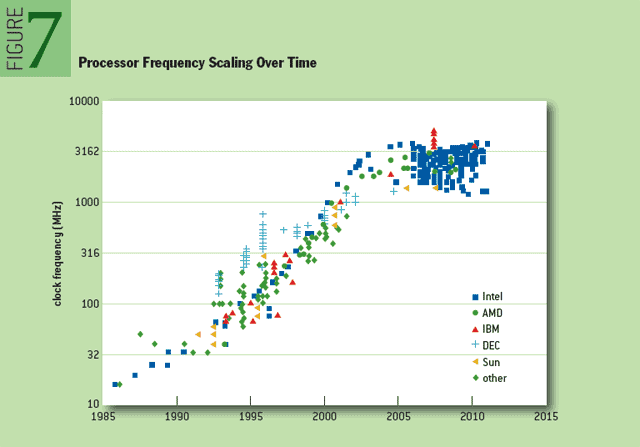goldstone77 :
Maybe you couldn't see, so let me blow up the image for you! That's IBM shattering the Intel Wall created on that graph you linked. If you notice IBM isn't behind the wall it has passed it significantly. Intel design limits don't apply to IBM.
Anyone can check that IBM also hitt the frequency wall. Until 2005 IBM was increasing frequencies at a faster pace. Then the GHz race stopped almost abruptly when they did hit the wall.
jaymc :
I don't think so Juan my statement is completely accurate !
To the best of my understanding it goes something like this,
If you shrink them small enough the gates in the chip stop working an energy starts to just to pass through closed gates (It's like it teleport's to the other side)...Really strange behaviour for sure, hence a breakdown in the laws of physics as we know it. Quantum Tunnelling it's called !
Hello this is the reason were gonna hit a wall with shrinking nodes (even if the tech makes it possible)... eventually physics just will not behave as it should as we enter the quantum realm...
By the way didn't you also claim that Epyc was dreadful, An predict it would not make it as a server chip in the data centre's, an never receive any design wins due to it's really high latency ?
Quantum tunneling is a physical phenomena that follows from the laws of physics. The physical laws that drive quantum tunneling have been known during 100 years.
I didn't say that EPYC wouldn't get some desing win, even Bulldozer and Itanium got some desing wins, and both were terrible designs. What I said is that EPYC would be massively rejected, with customer choosing other CPUs. I predicted EPYC would be crushed by both sides: ARM and Intel. And data just demonstrates it. Datacenters are massively purchasing Xeon, Cavium and Qualcomm, and rejecting EPYC. Did you read the links that I gave? What server CPU chose Microsoft for powering most of its datacenters? Also latency is only one of the problems that EPYC has.
aldaia :
IBM zEC12 (2012) built on 32 nm
Stock Frequency 5.5 GHz
aldaia :
IBM Z14stock frequency 5.2 GHz (note IBM uses 14 HP)
The IBM Z series also shows the frequency wall. Until 2008 the increase in clocks was very fast. Then the GHz race stopped almost abruptly and even clocks reduced a bit when IBM hit the wall
Documents from 2006 and a document talking from the Intel POV. Right...
The laws of physics and the atomic structure of silicon have not changed since 2006. Also the same laws apply to Intel than to AMD, IBM, or anything else.
aldaia :
You are wrong. There is no frequency wall here. This figure actually shows we have hit a POWER WALL (actually it should be named cooling wall). Frequency wall is well beyond current processor frequencies and nobody in micro architecture considers it a wall TODAY. The real wall is POWER.
Why is IBM getting higher frequencies than anybody else (even with inferior process)? Because they are willing to spend more on a cooling solution. IBM usually designs for TDPs in the 200-400W range. IBM MCM's are famous for disipating beyond 2KW.
In fact, with the proper cooling, it is possible to reach frequencies well beyond 8 GHz, almost 9 GHz.
https://valid.x86.fr/lpza4n
This is proof that, so far frequency, is only limited by power, and therefore cooling. We have yet to reach any frequency wall.
The power wall and the frequency wall are related, but the concepts wouldn't be confused, because the two walls aren't the same. That is the reason why the
power wall and the
frequency wall are discussed by separate.
https://books.google.es/books?id=48eOVJYAe9oC&pg=PA348&lpg=PA348&dq=%22Frequency+wall%22+cpu&source=bl&ots=CHteanLD3Q&sig=Bxot1Ffb1NmdPmORuwQLtgOVoqE&hl=en&sa=X&ved=0ahUKEwjQid3_tZHYAhUCNxQKHerYDoEQ6AEIRjAI#v=onepage&q=%22Frequency%20wall%22&f=false
In fact, it is the power wall which has an incorrect name, because the problem is not on the amount of power, but in the
power density. One can double the power if the area is doubled. The problem is when one double the power maintaining the area. Or alternatively when one maintains the power whereas reducing the area to one half with a die shrink.
We know that with exotic cooling as LN2 we can go above 5GHz. That doesn't disprove the existence of a frequency wall, because the limit takes different values depending of the cooling used: air, liquid, oil, LN2,...
The wall is around 6GHz on air and around 9GHz on LN2.








